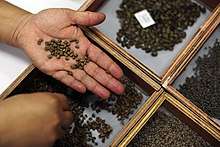Gene bank
Gene banks are a type of biorepository which preserve genetic material. For plants, this is done by in vitro storage, freezing cuttings from the plant, or stocking the seeds (e.g. in a seedbank). For animals, this is done by the freezing of sperm and eggs in zoological freezers until further need. With corals, fragments are taken and stored in water tanks under controlled conditions.[1] Genetic material in a 'gene bank' is preserved in a variety of ways, such as freezing at -196° Celsius in liquid nitrogen, being placed in artificial ecosystems, and put in controlled nutrient mediums.
Accession is the common term given to an individual sample in a gene bank, such as a distinct species or variety.
In plants, it is possible to unfreeze the material and propagate it. However, in animals, a living female is required for artificial insemination. While it is often difficult to use frozen animal sperm and eggs, there are many examples of it being done successfully.
In an effort to conserve agricultural biodiversity, gene banks are used to store and conserve the plant genetic resources of major crop plants and their crop wild relatives. There are many gene banks all over the world, with the Svalbard Global Seed Vault being considered the most famous one.[2]
The database of the largest gene banks in the world can be queried via a common website, Genesys.
Types of gene banks
Seed bank
A seed bank preserves dried seeds by storing them at a very low temperature. Spores and pteridophytes are conserved in seed banks, but other seedless plants, such as tuber crops, cannot be preserved this way. The largest seed bank in world is the Millennium Seed Bank housed at the Wellcome Trust Millennium Building (WTMB), located in the grounds of Wakehurst Place in West Sussex, near London.[3]

Tissue bank
In this technique, buds, protocorm and meristematic cells are preserved through particular light and temperature arrangements in a nutrient medium. This technique is used to preserve seedless plants and plants that reproduce sexually.
Cryobank
In this technique, a seed or embryo is preserved at very low temperatures. It is usually preserved in liquid nitrogen at -196 °C. This is helpful for the conservation of species facing extinction.[4] Cryobanks are utilized for the cryoconservation of animal genetic resources[5]

Storage of pollen
This is a method in which pollen grains are stored. Using this technique, plants with one set of chromosomes can be made. The pollen is stored in liquid nitrogen. This method is useful for crossbreeding.
Field gene bank
This is a method of planting plants for the conservation of genes. For this purpose, an ecosystem is created artificially. Through this method, one can compare the differences among plants of different species and can study them in detail. It needs more land, adequate soil, weather, etc. Germ plasma of important crops are conserved through this method. 42,000 varieties of rice are conserved in the Central Rice Research Institute in Orissa.
See also
External links
References
- "青汁と口臭とサプリメントと運動". www.cdnn.info. Retrieved 1 March 2017.
- On practical and theoretical differences between a storage and a gene bank, see Nicole C. Karafyllis (ed.): Theorien der Lebendsammlung. Pflanzen, Mikroben und Tiere als Biofakte in Genbanken (in German), Freiburg: Karl Alber 2018 (Lebenswissenschaften im Dialog Vol. 25) ISBN 978-3-495-48975-8
- Drori, Jonathan (posted May 2009, filmed February 2009). "Why we're storing billions of seeds". TED2009. TED. Retrieved 2011-12-11. Check date values in:
|date=(help) - "Cryo bank". CGIAR Genetic Resources Systems: Phase 2. Collective Action for the Rehabilitation of Global Public Goods. Retrieved 23 January 2012.
- ’’Cryoconservation of Animal Genetic Resources.’ ‘Rep. Rome: Food and Agriculture Organization of the United Nations, 2012. FAO Animal Production and Health Guidelines No. 12. Print.
- Ellis, R.H., T.D. Hong and E.H. Roberts (1985). Handbook of Seed Technology for Genebanks Vol. II: Compendium of Specific Germination Information and Test Recommendations. IBPGR (now Bioversity International). Rome, Italy. Archived from the original on 11 December 2008.CS1 maint: multiple names: authors list (link)
- Engels, J.M.M. and L. Visser, editors. (2003). A Guide to Effective Management of Germplasm Collections. CABI, IFPRI, IPGRI, SGRP. Archived from the original on 25 May 2007.CS1 maint: multiple names: authors list (link) 174 p.
- Kameswara, N., J. Hanson, M. E. Dulloo, K. Ghosh, A. Nowell and M. Larinde. (2006). Manual of Seed Handling in Genebanks. Bioversity International, CTA (Technical Center for Agricultural and Rural Cooperation), FAO, ILRI. Archived from the original on 21 January 2008.CS1 maint: multiple names: authors list (link) 147 p.
- Koo, B., Pardey, P. G., Wright, B. D.; et al. (2004). Saving Seeds. CABI, IFPRI, IPGRI, SGRP. Archived from the original on 11 December 2008.CS1 maint: multiple names: authors list (link)
